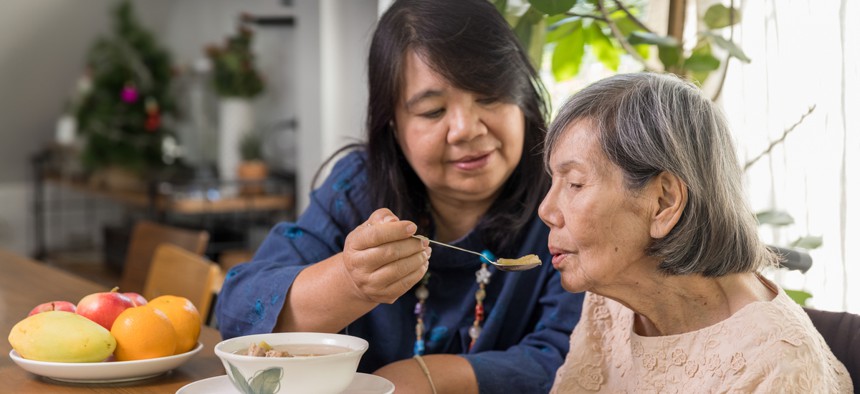Family Caregivers are the Health Care Workers that Vaccination Plans Overlook

Family caregivers are a critical part of our health care system. SHUTTERSTOCK
COMMENTARY | Millions of family members provide medical care for loved ones with disabling conditions. Excluding them from vaccination plans is symptomatic of a failure to formally integrate and recognize them as part of the health care system.
A close friend recently asked where she fits in the Covid-19 vaccination plan. She is the primary caregiver for her mother, providing round-the-clock care and emotional support—but is she a health care worker? To qualify for priority vaccination, she would need official documentation. But could she get it? Even if she could, my friend expressed ethical concerns about “jumping the line.”
She’s not alone. About 53 million family members and friends provide care to loved ones in the United States, representing a critical element of the long-term care system. They not only help to feed, bathe and dress their loved ones, they also routinely perform health care tasks like administering medicine, coordinating care and monitoring the physical, social and mental wellbeing of patients. In a recent survey, about half of family caregivers said that they perform at least one type of medical or nursing task. Despite this, they are often overlooked members of the health care community.
In its vaccination priority guidelines, the National Academies of Sciences recommended taking an expansive definition of health care workers that includes unpaid family caregivers. Yet only three states explicitly mentioned family caregivers in their initial vaccination plans. To some extent, this is being remedied. In early February, at least eight other states offered additional guidance or clarification on where family caregivers fall within their vaccination plan. Still, the information can be vague, inconsistent or difficult to find. This has left people like my friend wading through myriad websites and documents trying to figure out where they stand.
In states with no such guidance, there are stories about some caregivers negotiating other paths to vaccination. That isn’t how things should go. Keeping family caregivers out of the “formal” plan means less awareness of what the options are, places more stress on caregivers to navigate an already complex system, and in the end may be preventing people who should have a right to priority vaccination from getting their shot in a timely way.
But the situation also highlights a more fundamental gap in the health care system. Family caregivers are not integrated as part of a patient’s health care team. Just as they are being left out of the vaccination conversation, they will be left out of other policy decisions until this critical role is formally recognized.
In a recent RAND report, my colleague and I describe barriers that keep family caregivers outside the formal health care system. A major one is the difficulty health systems have identifying family caregivers. In part, this is because some family members do not view themselves as “caregivers.” Instead, they see themselves as providing support for a loved one. And most medical records aren’t set up to record information about family caregivers.
Veterans Affairs (VA) is a notable exception to this. The VA recently took explicit steps to incorporate caregivers into the health care system. As a result, those who are registered with its Program of Comprehensive Assistance for Family Caregivers can be prioritized for vaccination once the veteran they care for becomes eligible.
The pandemic has made family caregivers front-line workers. They can't be left out of important discussions around vaccination priorities and how to minimize the virus’s risk to those with compromised health. As a recent opinion piece argued, prioritizing vaccination of caregivers would have wide-ranging benefits, protecting caregivers, patients and health care providers.
Priority vaccination for caregivers could also mitigate the economic gender disparities the pandemic has created. Women are the ones most likely to be performing caregiving duties during the pandemic, not just for children, but also for those with chronic conditions and disabilities. Women may be leaving the labor force to form “pods” with those they care for. Vaccinating these women could provide opportunities for them to reenter the workforce without fear that they might infect the people who they provide care for.
President Joe Biden recently laid out his five-step vaccine plan, which begins by working with states to add more priority groups to those eligible for the vaccine. Hopefully that process will spur states and counties to explicitly acknowledge family caregivers as the essential health workers that they are and pave the way to integrate them into the formal health care system.
Esther M. Friedman is a behavioral and social scientist and director of the Caregiving Initiative at the nonprofit, nonpartisan RAND Corporation.
NEXT STORY: Part South By Southwest, Part Burning Man—But for Local Leaders. Introducing: Govapalooza





